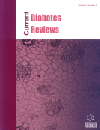- Home
- A-Z Publications
- Current Diabetes Reviews
- Previous Issues
- Volume 7, Issue 5, 2011
Current Diabetes Reviews - Volume 7, Issue 5, 2011
Volume 7, Issue 5, 2011
-
-
Hypoxia and Oxidative Stress in the Causation of Diabetic Retinopathy
More LessAuthors: Geoffrey B. Arden and Sobha SivaprasadDiabetic retinopathy is associated with hyperglycemia, and there is convincing evidence that oxidative stress (the overproduction of reactive oxygen species (ROS)) measured indirectly in patients, is related to the severity of diabetic complications. Also, reducing such stress by various means, including drugs and reducing hyperglycemia, decreases the rate of development of diabetic retinopathy (DR). It is therefore sup Read More
-
-
-
Gastric Bypass and Diabetes: Past, Present and Future
More LessAuthors: Tse-I Lee, Jui-Hung Chen, Ting-Chia Weng, Keong Chong, Wei-Jei Lee and Lee-Ming ChuangContext: Owing to the pathogenic role of insulin resistance and beta-cell dysfunction in type 2 diabetes, the clinical manifestation of this disease is extremely complex and is often associated with obesity. In recent years, Roux-en-Y gastric bypass (RYGB) surgery, which was originally developed to treat morbid obesity, has been found to have therapeutic potential for diabetes. However, the underlying mechanisms of the therapeuti Read More
-
-
-
The Role of Oxidative Stress in the Pathogenesis of Type 2 Diabetes Mellitus Micro- and Macrovascular Complications: Avenues for a Mechanistic-Based Therapeutic Approach
More LessA growing body of evidence suggests that oxidative stress plays a key role in the pathogenesis of micro- and macrovascular diabetic complications. The increased oxidative stress in subjects with type 2 diabetes is a consequence of several abnormalities, including hyperglycemia, insulin resistance, hyperinsulinemia, and dyslipidemia, each of which contributes to mitochondrial superoxide overproduction in endothelial cell Read More
-
-
-
Linagliptin: A Novel Xanthine-Based Dipeptidyl Peptidase-4 Inhibitor for Treatment of Type II Diabetes Mellitus
More LessType 2 diabetes mellitus causes significant morbidity and mortality on account of its progressive nature and results in considerable burden on healthcare resources. Current treatment strategies have only limited long-term efficacy and tolerability given the progressive nature of the disease leading to inadequate glycemic control and are also associated with undesirable side effects such as weight gain, hypoglycemia and gas Read More
-
-
-
Signalling Satiety and Starvation to β-Cell Insulin Secretion
More LessAuthors: Mark J. Holness, Sharif Hegazy and Mary C. SugdenThe impact of bariatric surgery on insulin sensitivity and glucose tolerance has refocused interest in the role of gut-derived factors in the regulation of insulin secretion and action. The incretins, glucose-dependent insulinotropic peptide (GIP) and glucagon-like peptide-1 (GLP-1) are released from endocrine cells in the small intestinal mucosa primarily in response to oral nutrient ingestion. They have various effects, including augm Read More
-
-
-
The Epithelial-to-Mesenchymal Transition of Human Pancreatic β-Cells: Inductive Mechanisms and Implications for the Cell-Based Therapy of Type I Diabetes
More LessAuthors: Anthony M.P. Montgomery and Mayra YebraAs a therapy for type I diabetes, islet transplantation provides clear benefits in terms of increased insulinindependence and a reduced risk of hypoglycemia. However, a critical shortage of donor pancreata means that few can benefit from this approach. The ex vivo expansion of human β-cells prior to transplantation could ameliorate this problem, however, attempts to grow large numbers of β-cells that retain their native Read More
-
-
-
Central Insulin and Insulin-Like Growth Factor-1 Signaling - Implications for Diabetes Associated Dementia
More LessAuthors: Johanna Zemva and Markus SchubertPatients with type 2 diabetes (T2DM) have a two- to three-fold increased risk for Alzheimer's disease (AD), the most common form of dementia. Vascular complications might explain partially the increased incidence of neurodegeneration in patients with T2DM. Alternatively, neuronal resistance for insulin/insulin-like growth factor-1 (IGF- 1) might represent a molecular link between T2DM and AD, characterizing AD as “ Read More
-
Volumes & issues
-
Volume 21 (2025)
-
Volume 20 (2024)
-
Volume 19 (2023)
-
Volume 18 (2022)
-
Volume 17 (2021)
-
Volume 16 (2020)
-
Volume 15 (2019)
-
Volume 14 (2018)
-
Volume 13 (2017)
-
Volume 12 (2016)
-
Volume 11 (2015)
-
Volume 10 (2014)
-
Volume 9 (2013)
-
Volume 8 (2012)
-
Volume 7 (2011)
-
Volume 6 (2010)
-
Volume 5 (2009)
-
Volume 4 (2008)
-
Volume 3 (2007)
-
Volume 2 (2006)
-
Volume 1 (2005)
Most Read This Month
Article
content/journals/cdr
Journal
10
5
false
en


